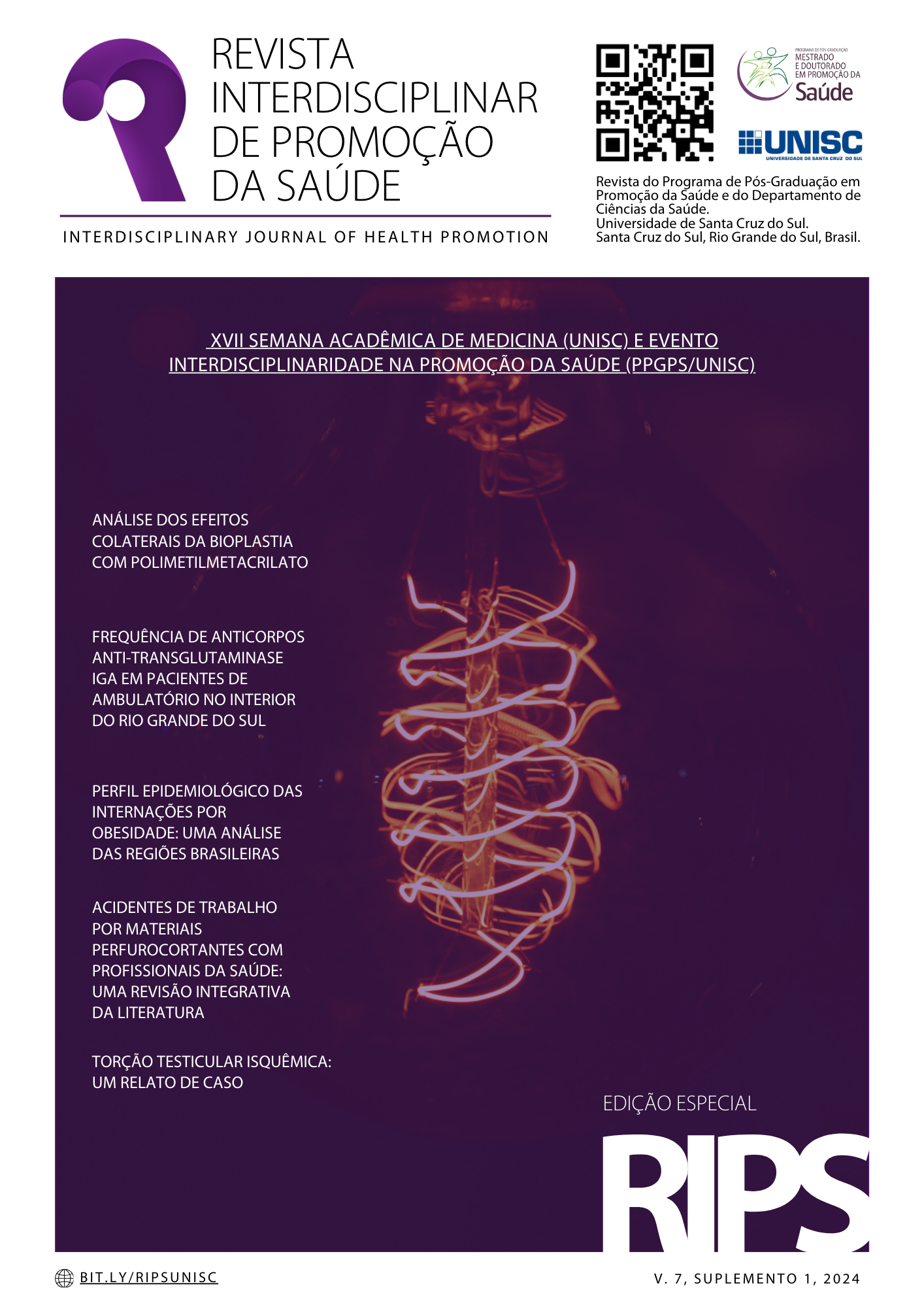Epidemiological profile of admissions for obesity: an analysis of brazilian regions
DOI:
https://doi.org/10.17058/rips.v7isuplemento.19704Keywords:
Obesidade, Hospitalização, SaúdeAbstract
Introduction: obesity is portrayed in the literature as a worldwide epidemic that is difficult to control. The negative consequences of this problem for the population's health justify managers' concern for its prevention and treatment, making it a public health priority. Objective: to know the epidemiological profile of hospitalizations for obesity in the regions of Brazil, between the years 2019 and 2023, for females and males in the categories: childhood and pre-adolescence, adolescence and adults and the elderly. Method: A cross-sectional, observational, descriptive study was carried out, with data on hospital admissions from the SUS Hospital Internation System (SIH) aggregated by region. The calculation of the coefficient of variability (CV%) of the hospitalizations was carried out for each region. Results: The region with the greatest variability in the number of hospitalizations in childhood and pre-adolescence for the female sex was the Southern region (CV% = 20.04), while for the male sex it was the Northern region (CV% = 27.75). In the adolescence and adults category, the greater variability for the female sex was also in the Southern region (CV% = 6.67) and for the male sex in the Northern region (CV% = 6.62). The Northern region presents a greater variability in the number of hospitalizations of children, both for the female sex (CV% = 11.22) and for the male sex (CV% = 9.36). Conclusion: A large number of hospitalizations related to obesity have been observed in all regions of the country. Showing the need for public health policies aimed at modifying this scenario.
Downloads
References
Durans LHF, Miranda TC, Silva HNS et al. Aspectos e fatores associados à obesidade na adolescência. In: Dias CJM. Exercício físico e saúde do adolescente. Atena Editora 2023. 102-110. doi: https://doi.org/10.22533/at.ed.3512328099
Ramos APS, Melo MFGA, Paiva JA et al. Perfil epidemiológico das internações por obesidade no Brasil, no período de 2017 a 2021. Research, Society and Development 2022; 11(4):e39111427460. doi: http://dx.doi.org/10.33448/rsd-v11i4.27460
World health organization. World Health Organization Obesity: preventing and managing the global epidemic. Report of a WHO consultation WHO Technical Report Series, v. 894, 2000. doi: https://apps.who.int/iris/handle/10665/42330
Claes L, Jeannin R, Braet C. Obesity: Etiology, Assessment and Treatment. Elsevier eBooks 2022; 8:388-405. doi: https://doi.org/10.1016/B978-0-12-818697-8.00124-2
Mehrzad R. Chapter 4 - Etiology of obesity. Mehrzad R, editor. ScienceDirect. Elsevier 2020; 43-54. doi: https://doi.org/10.1016/B978-0-12-818839-2.00004-1
Santolin CB. História da obesidade na classificação internacional de doenças (CID): de 1900 a 2018. Arq ciências saúde UNIPAR 2021; 25(3):167-172. doi: https://doi.org/10.25110/arqsaude.v25i3.2021.8045
Ferreira APS, Szwarcwald CL, Damacena GN et al. Increasing trends in obesity prevalence from 2013 to 2019 and associated factors in Brazil. Rev Bras Epidemiol 2021; 24(2). doi: https://doi.org/10.1590/1980-549720210009.supl.2
Ramos DBN, Burlandy L, Dias PC et al. Propostas governamentais de ações de prevenção e controle do sobrepeso e obesidade sob perspectiva municipal. Cad Saude Publica 2020; 36(6). doi: https://doi.org/10.1590/0102-311X00116519
Nilson EAF, Andrade RCS, Brito DA et al. Custos atribuíveis a obesidade, hipertensão e diabetes no Sistema Único de Saúde, Brasil, 2018. Rev Panam Salud Publica 2020; 44(32):1. doi: https://doi.org/10.26633/RPSP.2020.32
Ferrari G, Giannichi B, Resende B et al. The economic burden of overweight and obesity in Brazil: perspectives for the Brazilian Unified Health System. Public Health 2022; 207:82-87. doi: https://doi.org/10.1016/j.puhe.2022.03.015
Coleman KJ, Tiller CL, Sanchez J et al. Prevention of the epidemic increase in child risk of overweight in Low-Income Schools. Arch Pediatr Adolesc Med 2005; 159(3):217-224. doi: https://doi.org/10.1001/archpedi.159.3.217
Anselmo AC, Mitragotri S. An overview of clinical and commercial impact of drug delivery systems. J Control Release 2014; 190:15-28. doi: https://doi.org/10.1016/j.jconrel.2014.03.053
Zhang Y, Liu Q, Yu J et al. Locally induced adipose tissue browning by microneedle patch for obesity treatment. ACS Nano 2017; 11(9):9223-9230. doi: https://doi.orbg/10.1021/acsnano.708434
Syn NL, Cummings DE, Wang LZ et al. Association of metabolic–bariatric surgery with long-term survival in adults with and without diabetes: a one-stage meta-analysis of matched cohort and prospective controlled studies with 174 772 participants. Lancet 2021; 397(10287):1830–1841. doi: https://doi.org/10.1016/S0140-6736(21)00591-2
Castanha CR, Castanha AR, Belo GQMB et al. Avaliação da qualidade de vida, perda de peso e comorbidades de pacientes submetidos à cirurgia bariátrica. Rev Col Bras Cir 2018; 45 (3). doi: https://doi.org/10.1590/0100-6991e-20181864
Frikke-Schimidt H, O’Rourke RW, Lumeng CN et al. Does bariatric surgery improve adipose tissue function?. Obesity Reviews 2016; 17(9):795-809. doi: https://doi.org/10.1111%2Fobr.12429
Frigolet ME, Dong-Hoon K, Canizales-Quinteros S et al. Obesidad, tejido adiposo y cirugía bariátrica. Bol Med Hosp Infant Mex 2020; 77(1):1665-1146. doi: https://doi.org/10.24875/bmhim.19000115
Cancello R, Zuliam A, Gentilini D et al. Permanence of molecular features of obesity in subcutaneous adipose tissue of ex-obese subjects. International Journal of Obesity 2013; 37(6):867-873. doi: https://doi.org/10.1038/ijo.2013.7
Andersson DP, Eriksson HD, Thorell A et al. Changes in subcutaneous fat cell volume and insulin sensitivity after weight loss. Diabetes Care 2014; 37(7):1831-1836. doi: https://doi.org/10.2337/dc13-2395
Schauer PR, Bhatt DL, Kirwan JP et al. Bariatric surgery versus intensive medical therapy for diabetes--3-year outcomes. NEJM 2017; 370(21):2002-2013. doi: https://doi.org/10.1056%2FNEJMoa1401329
Hair JF, Matthews LM, Matthews RL, Sarstedt M. PLS-SEM or CB-SEM: updated guidelines on which method to use. Int. J. Multivariate Data Analysis 2017; 1(2): 107–123. doi: https://doi.org/10.1504/IJMDA.2017.087624
Wang C, Horby PW, Hayden FG et al. A novel coronavirus outbreak of global health concern. Lancet 2020; 395(10223): 470-473. doi: https://pubmed.ncbi.nlm.nih.gov/31986257/
Favero LPL, Belfiore PP, Silva FL et al. Análise de dados: modelagem multivariada para tomada de decisões. 2009. doi: https://repositorio.usp.br/item/001769290
Downloads
Published
How to Cite
Issue
Section
License
A submissão de originais para este periódico implica na transferência, pelos autores, dos direitos de publicação impressa e digital. Os direitos autorais para os artigos publicados são do autor, com direitos do periódico sobre a primeira publicação. Os autores somente poderão utilizar os mesmos resultados em outras publicações indicando claramente este periódico como o meio da publicação original. Em virtude de sermos um periódico de acesso aberto, permite-se o uso gratuito dos artigos em aplicações educacionais e científicas desde que citada a fonte conforme a licença CC-BY da Creative Commons.




